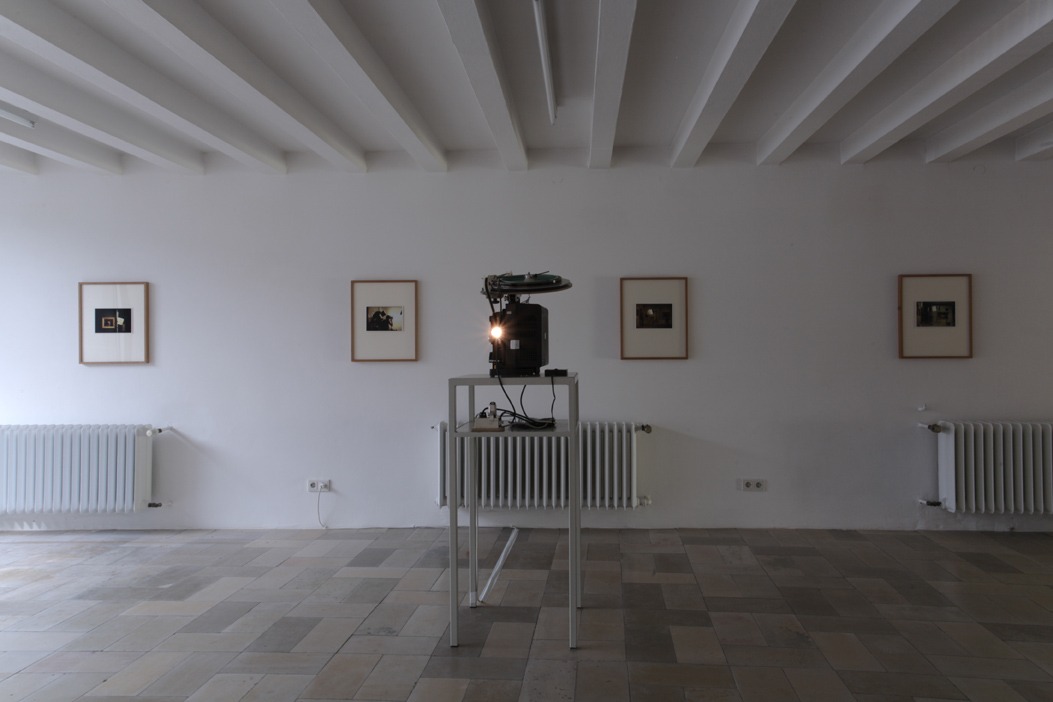Olivier Foulon
The Soliloquy of the Broom ⁄ Selbstgespräch eines Besens
23 Aug - 28 Sep 2008

Olivier, Foulon, The Soliloquy of the Broom, exhibition view, Kölnischer Kunstverein 2008, photo: Simon Vogel
The title of the exhibition TheSoliloquy of the Broom/Selbstgespräch eines Besens by the artist Olivier Foulon (*Brussels, 1976) hovers between make-up, masquerade and painting. At the center is the painting Jo, theBeautifulIrish Girl by Gustave Courbet, which the French painter produced in Trouville in 1865. It shows a lady named Jo, lover and model of the artist James Whistler, looking at herself and her hair in a mirror. Due to great demand, Gustave Courbet copied this painting several times. The four versions are now in the Metropolitan Museum, New York, the Nelson-Atkins Museum, Kansas City, the National Museum, Stockholm and a private collection. Olivier Foulon has brought the four pictures together in a 16mm film and works with the idea of ̈Modells as a template for a painting, which itself becomes the model wird ̈ and illustrates with this project early forms of artistic mass production.
A publication published by Gevaert éditions is the second part of the exhibition. Olivier Foulon selects from an online archive three texts from the art magazine Artforum International from 2005 about the artist Michael Krebber and republishes them. The texts have already been cleared of the originally accompanying illustrations and figures, the “picture make-up”, on their way from print to online format and provided with the laconic reference “illustration omitted”.
In both works, Foulon questions the meaning and function of an artist’s personal signature. By copying his own pictures, Gustave Courbet questions the idea of the artist’s handwriting just as Michael Krebber does in his work. In the form of annually changing exhibitions, the series Der sprende Punkt provides insight into the archives of institutions or individuals that offer important points of departure for curatorial work. The starting point for Foulon’s research was the Marcel Proust Archive of Prof. Dr. Reiner Speck. Olivier Foulon is an artist who creates in his work arrangements in which art history can be negotiated and read in a new way. His conceptual approach is based on the appropriation and play with specific historical models. He is concerned with the relationship between original, copy and reproduction, and with the reading and presentation of works of art and the role of the artist within them.
Our thanks go to the Metropolitan Museum, New York, Nelson-Atkins Museum, Kansas City, National Museum, Stockholm, Sotheby’s Cologne/New York and the representation of the French Community of Belgium and the Walloon Region
Co-production of the Kölnischer Kunstverein and If I can’t dance, Amsterdam.
A publication published by Gevaert éditions is the second part of the exhibition. Olivier Foulon selects from an online archive three texts from the art magazine Artforum International from 2005 about the artist Michael Krebber and republishes them. The texts have already been cleared of the originally accompanying illustrations and figures, the “picture make-up”, on their way from print to online format and provided with the laconic reference “illustration omitted”.
In both works, Foulon questions the meaning and function of an artist’s personal signature. By copying his own pictures, Gustave Courbet questions the idea of the artist’s handwriting just as Michael Krebber does in his work. In the form of annually changing exhibitions, the series Der sprende Punkt provides insight into the archives of institutions or individuals that offer important points of departure for curatorial work. The starting point for Foulon’s research was the Marcel Proust Archive of Prof. Dr. Reiner Speck. Olivier Foulon is an artist who creates in his work arrangements in which art history can be negotiated and read in a new way. His conceptual approach is based on the appropriation and play with specific historical models. He is concerned with the relationship between original, copy and reproduction, and with the reading and presentation of works of art and the role of the artist within them.
Our thanks go to the Metropolitan Museum, New York, Nelson-Atkins Museum, Kansas City, National Museum, Stockholm, Sotheby’s Cologne/New York and the representation of the French Community of Belgium and the Walloon Region
Co-production of the Kölnischer Kunstverein and If I can’t dance, Amsterdam.

